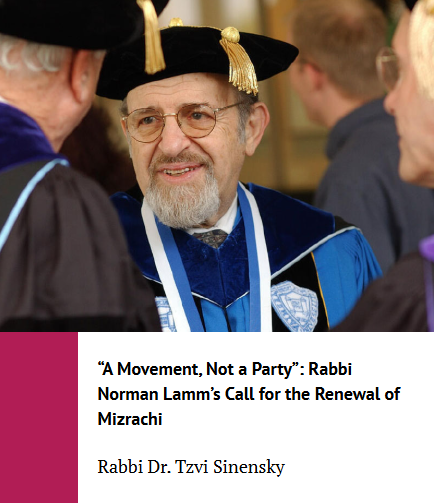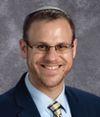“A Movement, Not a Party” Rabbi Norman Lamm’s Call for the Renewal of Mizrachi

[originally published in Hamizrachi Magazine]
This essay, exploring Rabbi Norman Lamm’s deep relationship with the Mizrachi movement, is occasioned by the launch of the new Rabbi Lamm Digital Archive at lammlegacy.org – an online library of more than 5,500 curated documents that shed new light on his leadership, thought, and enduring impact.
The launch of the Rabbi Norman Lamm Legacy Digital Library opens a new chapter in the preservation of Modern Orthodoxy’s intellectual and institutional history. Among the thousands of newly accessible documents is a sustained, candid, and impassioned record of Rabbi Lamm’s lifelong engagement with Mizrachi. That relationship speaks not only to a storied past but to the complex moment we confront today.
Rabbi Lamm’s commitment to Mizrachi was no abstraction. In the early years of his career, he and his wife Mindy z”l were active in multiple Manhattan chapters of the movement while he served at The Jewish Center for eighteen years beginning in 1958. In a 1973 letter to a Mizrachi leader in South Africa, Rabbi Lamm expressed his “loyalty to the Mizrachi ideal,” noting that he had “spoken on behalf of Mizrachi on many occasions” and reaffirming his readiness to speak on their behalf during his coming monthlong visit to the country. It was a telling affirmation of his longstanding conviction that Religious Zionism, rightly understood, was the natural ideological home of a Torah Jew in the modern world.
Yet Rabbi Lamm was equally convinced that this home required constant upkeep. As he put it in his 1982 address to the World Mizrachi Conference – convened in Jerusalem in the fraught months following Israel’s invasion of Lebanon and amid declining fortunes for the National Religious Party – “Some of us have begun to feel like vestiges of the past instead of harbingers of the future.”
By the early 1980s, the warning signs were impossible to ignore. In Israel, Mizrachi had become increasingly identified with the Mafdal, whose political strength had peaked in the years after the Six-Day War. That influence eroded in the late 1970s and early 1980s, as factionalism weakened unity, the Likud’s 1977 rise shifted the political map, and new Religious Zionist currents – particularly Gush Emunim – captured the public imagination with settlement activism and uncompromising rhetoric.
In the United States, the once-vibrant chapters that had mobilized for Israel’s independence in 1948 and rallied during the Six-Day War in 1967 were shrinking. The unifying glow of those years had been replaced by the reckonings of the Yom Kippur War – which pierced Israel’s aura of invincibility – and the First Lebanon War, which stirred moral and strategic debates across the Jewish world. In an era drawn to ideological purity, Mizrachi’s tradition of nuance and synthesis could seem less like a strength and more like a liability.
Rabbi Lamm did not shrink from this reality. In a pivotal December 1982 address, he called for a chanukat ha-Mizrachi – a rededication of the movement. Drawing from Jewish historical memory, he observed that we commemorate not the original building of the Mishkan or the First Beit HaMikdash, but the rededication of the Second Beit HaMikdash on Chanukah. Rebuilding, he argued, is harder, less glamorous, but ultimately more worthy of celebration.
His prescription for renewal was threefold: organizational distinction, fraternal healing, and educational investment.
First, Mizrachi had to reassert its identity as a movement, not merely the political arm of a party. “The Movement embodies an idea,” he reminded his listeners. “A Party is only a means to achieve and enhance it.” In the early 1980s, when Mafdal was increasingly absorbed in coalition bargaining and short-term maneuvering, blurring that line meant the party risked becoming spiritually unmoored and the movement ideologically hollow.
Second, the movement needed to heal itself. “There has been too little shalom bayit in our ranks,” he lamented. Strains between Israeli and Diaspora leadership – with Israelis focused on political influence and Diaspora leaders on education – had weakened trust. In Israel, tensions between Mafdal’s pragmatic old guard and younger Gush Emunim activists over settlements and political compromise deepened divisions, while disagreements over the Camp David Accords and the Lebanon War sharpened mistrust. For a movement claiming to represent Religious Zionism’s highest ideals, such rifts were untenable.
Finally – and most importantly – was the call for spiritual renewal. Mizrachi’s educational mission, he insisted, had to be restored to the center. “Torah must be the soul of the State,” he declared. “Without it, the body may survive, but it will be a body without direction, without conscience.” Without a deep intellectual and moral core, Religious Zionism risked becoming a slogan rather than a source of inspiration.
At Yeshiva University, Rabbi Lamm modeled what he preached. He proudly noted that over ten percent of YU alumni had made Aliyah – not because of recruitment campaigns, but because they had been steeped in a worldview where love of Torah and love of Zion reinforced each other. Hundreds more studied in hesder yeshivot, women’s seminaries, and other institutions infused with the Mizrachi ethos. “We have already proven,” he said, “that a Jew can fight to defend himself. What we must now prove is that we can live for something higher.”
What Mizrachi could offer, he argued, was exactly what the moment demanded: a Judaism that was intellectually serious, spiritually anchored, and neither escapist nor triumphalist – one that could affirm the State of Israel without reducing religion to politics, and embrace science and culture without surrendering halachic integrity.
It was a call for what he termed “radical moderation” – not bland centrism, but a principled synthesis grounded in clarity, humility, and courage. The relevance of that vision has only grown. In an age when some voices within Religious Zionism have drifted toward stridency, Rabbi Lamm’s insistence on resisting the pull of extremism and serving as a bridge between Torah and the wider society offers a vital corrective.
For such a vision to take root, he urged, Mizrachi needed leaders who were spiritually ambitious and morally uncompromising. “We must shun mediocrity,” he wrote. Its future would depend less on political machinery than on educators, scholars, and lay leaders whose character and commitments embodied the ideals they preached.
Thanks in no small measure to the leadership of Rabbi Doron Perez, Mizrachi has in recent years experienced a renaissance – expanding globally, deepening its educational mission, and inspiring a new generation with the ideals of Torah and Zionism. Rabbi Lamm would have been proud, but he would also have reminded us that pride is no substitute for purpose. To endure, Mizrachi must remain a movement of substance, not just activity; of ideas, not just institutions – rooted in Torat Yisrael and engaged with the world.
As Rabbi Lamm concluded in his 1982 keynote: “Maybe our potential is far greater than our sorry present reality would indicate. Let us make the present worthy of our magnificent potential.” The release of the archive invites us to take that challenge seriously – and to continue the sacred work of renewal.
